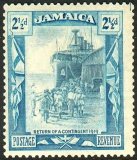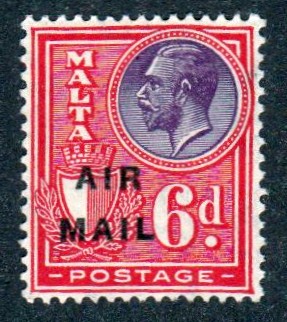
Discussion - Member to Member Sales - Research Center

Discussion - Member to Member Sales - Research Center



Login to Like
this post
To my eyes this was cancelled in Harbin, China. I don't have a suitable catalogue to identify it and I can't read the last two characters of the date. Has a look of the 1930/40's though.

Login to Like
this post
Harbin is in Manchuria, which under Japanese occupation, is referred to as Manchukuo. At the top center of the stamp is a symbol that is on most, if not all, of the stamps from there.

Login to Like
this post
Thank you gentlemen. Manchukuo it is.

Login to Like
this post
"At the top center of the stamp is a symbol that is on most, if not all, of the stamps from there."
Would the characters on either side of the central symbol be in the Manchu script?

Login to Like
this post
Being consistently curious ... it is
Manchuko Scott #97 from 1936-37

Login to Like
this post
I just looked up Harbin. It is the eighth largest city in China it seems with a greater metro population of over 10 million. It was a center of White Russian emigration and has been heavily influenced by its Russian population.
During the Japanese occupation in the 1930's Harbin was a center for brutal human experimentation by the Japanese military.

Login to Like
this post

06:26:56pm
Experiments on living humans, mostly Chinese, but including some Allied POWs was performed by the infamous Unit 731.
From Wikipedia;
" Instead of being tried for war crimes, the researchers involved in Unit 731 were secretly given immunity by the U.S. in exchange for the data they gathered through human experimentation.
Others that Soviet forces managed to arrest first were tried at the Khabarovsk War Crime Trials in 1949. Americans did not try the researchers so that the information and experience gained in bio-weapons could be co-opted into the U.S. biological warfare program, as had happened with Nazi researchers in Operation Paperclip.
On 6 May 1947, Douglas MacArthur, as Supreme Commander of the Allied Forces, wrote to Washington that "additional data, possibly some statements from Ishii probably can be obtained by informing Japanese involved that information will be retained in intelligence channels and will not be employed as 'War Crimes' evidence."[10] Victim accounts were then largely ignored or dismissed in the West as communist propaganda.
".
This is often the subject of University Ethics Classes.

2 Members
like this post.
Login to Like.
For some reason, I missed this thread when it first started.
One trick to identifying stamps of Manchukuo is that "logo" that you see in the top middle of the scan Antonio showed. (It kind of looks like 5 propellers, but it's supposed to be an orchid.)
I think there are a few Manchukuo stamps that don't have that "logo", but most do.

Login to Like
this post

I can't really read the cancel and having a hard time figuring out where this stamp is from. Thanks for any help.


Login to Like
this post

re: 20 Fen with Chinese letters - Where is this from?
To my eyes this was cancelled in Harbin, China. I don't have a suitable catalogue to identify it and I can't read the last two characters of the date. Has a look of the 1930/40's though.

Login to Like
this post
10:43:47am
re: 20 Fen with Chinese letters - Where is this from?
Harbin is in Manchuria, which under Japanese occupation, is referred to as Manchukuo. At the top center of the stamp is a symbol that is on most, if not all, of the stamps from there.

Login to Like
this post

re: 20 Fen with Chinese letters - Where is this from?
Thank you gentlemen. Manchukuo it is.

Login to Like
this post

re: 20 Fen with Chinese letters - Where is this from?
"At the top center of the stamp is a symbol that is on most, if not all, of the stamps from there."
Would the characters on either side of the central symbol be in the Manchu script?

Login to Like
this post
12:21:53pm
re: 20 Fen with Chinese letters - Where is this from?
Being consistently curious ... it is
Manchuko Scott #97 from 1936-37

Login to Like
this post

re: 20 Fen with Chinese letters - Where is this from?
I just looked up Harbin. It is the eighth largest city in China it seems with a greater metro population of over 10 million. It was a center of White Russian emigration and has been heavily influenced by its Russian population.
During the Japanese occupation in the 1930's Harbin was a center for brutal human experimentation by the Japanese military.

Login to Like
this post
Silence in the face of adversity is the father of complicity and collusion, the first cousins of conspiracy..
22 Aug 2017
06:26:56pm
re: 20 Fen with Chinese letters - Where is this from?
Experiments on living humans, mostly Chinese, but including some Allied POWs was performed by the infamous Unit 731.
From Wikipedia;
" Instead of being tried for war crimes, the researchers involved in Unit 731 were secretly given immunity by the U.S. in exchange for the data they gathered through human experimentation.
Others that Soviet forces managed to arrest first were tried at the Khabarovsk War Crime Trials in 1949. Americans did not try the researchers so that the information and experience gained in bio-weapons could be co-opted into the U.S. biological warfare program, as had happened with Nazi researchers in Operation Paperclip.
On 6 May 1947, Douglas MacArthur, as Supreme Commander of the Allied Forces, wrote to Washington that "additional data, possibly some statements from Ishii probably can be obtained by informing Japanese involved that information will be retained in intelligence channels and will not be employed as 'War Crimes' evidence."[10] Victim accounts were then largely ignored or dismissed in the West as communist propaganda.
".
This is often the subject of University Ethics Classes.

2 Members
like this post.
Login to Like.

re: 20 Fen with Chinese letters - Where is this from?
For some reason, I missed this thread when it first started.
One trick to identifying stamps of Manchukuo is that "logo" that you see in the top middle of the scan Antonio showed. (It kind of looks like 5 propellers, but it's supposed to be an orchid.)
I think there are a few Manchukuo stamps that don't have that "logo", but most do.

Login to Like
this post

